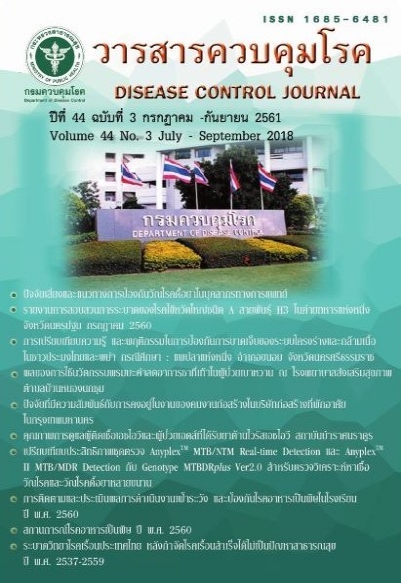Efficiency comparison of AnyplexTM MTB/NTM Real-time Detection and AnyplexTM II MTB/MDR Detection with Genotype MTBDRplus Ver2.0 for detection Mycobacterium tuberculosis and MDR-TB
DOI:
https://doi.org/10.14456/dcj.2018.27Abstract
Laboratory diagnosis for MTB and drug resistance TB is the main factor for success in tuberculosis treatment. Currently, molecular biology techniques are used for several infectious- diseases diagnostics because of its high sensitivity, high specificity, and uncomplicated, time-consuming effectiveness and could be used for screening tests. Although molecular biology technique for TB diagnostic which is endorsed by the World Health Organization (WHO) is Line Probe Assay (LPA); the reverse hybridization method, but many laboratories in Thailand use Real-time PCR for TB diagnostic instead. This study was aimed to compare Anyplex™ MTB/NTM Real-time Detection and Anyplex™ II MTB/MDR Detection by Real-time PCR method with Genotype MTBDRplus by LPA method for TB diagnosis on rifampicin-resistant TB (RIF-resistant TB), isoniazid-resistant TB (INH-resistant TB) and multidrug-resistant TB (MDR-TB) detection. One hundred and forty seven patients’ sputa which obtained from the laboratory of the Office of Disease Prevention and Control Region 5, Ratchaburi were parallelly tested by two methods. The results showed high efficacy of this Real-time PCR system by comparing with LPA. There are 100%, 88.89%, 100% and 100% of the sensitivities, 100%, 99.06%, 100% and 100% of the specificities, 100% 88.89%, 100% and 100% of the positive predictive values and 100%, 99.06%, 100% and 100% of the negative predictive values for TB, RIF-resistant TB, INH-resistant TB and MDR-TB detection, respectively. In conclusion, this Real-time PCR; its simple, convenient and rapid technique, could be the high performance method for TB diagnostic and its TB resistance detection. This method can assist the medical personnel for the proper TB treatments for controlling the spreading out of TB in the communities.
Downloads
References
2. Kim MJ, Nam YS, Cho SY, Park TS, Lee HJ. Comparison of the Xpert MTB/RIF Assay and Real-time PCR for the detection of Mycobacterium tuberculosis. Ann Clin Lab Sci 2015;45:327-32.
3. Zhang ZX, Sng LH, Yong Y, Lin LM, Cheng TW, Seong NH, et al. Delays in diagnosis and treatment of pulmonary tuberculosis in AFB smear-negative patients with pneumonia. Int J Tuberc Lung Dis 2017;21:544-9.
4. Suthum K, Tipkrua N. Comparison of Mycobacterium tuberculosis drug resistance testing between Real-time PCR using a Dual Priming Oligonucleotide Method and drug susceptibility testing by The BACTECTM MGITTM 960 System. J Med Tech Assoc Thailand 2013;41:4654-66.
5. Lawn SD, Mwaba P, Bates M, Piatek A, Alexander H, Marais BJ, et al. Advances in tuberculosis diagnostics: the Xpert MTB/RIF assay and future prospects for a point of care test. Lancet Infect Dis 2013;13:349-61.
6. Brossier F, Veziris N, Truffot-Pernot C, Jarlier V, Sougakoff W. Performance of the genotype MTBDR Line Probe Assay for detection of resistance to rifampin and isoniazid in strains of Mycobacterium tuberculosis with low- and high-level resistance. J Clin Microbiol 2006;44:3659-64.
7. Rufai SB, Kumar P, Singh A, Prajapati S, Balooni V, Singh S. Comparison of Xpert MTB/RIF with Line Probe Assay for Detection of Rifampin-Monoresistant Mycobacterium tuberculosis. J Clin Microbiol 2014;52:1846-52.
8. Lv Z, Zhang M, Zhang H, Lu X. Utility of Real-Time Quantitative Polymerase Chain Reaction in Detecting Mycobacterium tuberculosis. Biomed Res Int 2017;2017:1-5.
9. Hance AJ, Grandchamp B, Lévy-Frébault V, Lecossier D, Rauzier J, Bocart D, et al. Detection and identification of mycobacteria by amplification of mycobacterial DNA. Mol Microbiol 1989;3:843-9.
10. Patel RJ, Fries JWU, Piessens WF, Wirth DF. Sequence analysis and amplification by polymerase chain reaction of a cloned DNA fragment for identification of Mycobacterium tuberculosis. J Clin Microbiol 1990;28:513-8.
11. Marin M, Viedma DG, Ruiz-Serrano MJ, Bouza E. Rapid direct detection of multiple rifampin and isoniazid resistance mutations in Mycobacterium tuberculosis in respiratory samples by real-time PCR. Antimicrob Agents and Chemother 2004;48:4293–300.
12. Perry MD, White PL, Ruddy M. Potential for use of the Seegene Anyplex MTB/NTM real-time detection assay in a regional reference laboratory. J Clin Microbiol 2014;52:1708-10.
13. Molina-Moya B, Lacoma A, Prat C, Pimkina E, Diaz J, García-Sierra N, et al. Diagnostic accuracy study of multiplex PCR for detecting tuberculosis drug resistance. J Infect 2015;71:220-30.
14. Deggim-Messmer V, Bloemberg GV, Ritter C, Voit A, Hömke R, Keller PM, et al. Diagnostic molecular mycobacteriology in regions with low tuberculosis endemicity: combining Real-time PCR Assays for detection of multiple mycobacterial pathogens with Line Probe Assays for identification of resistance mutations. EBioMedicine 2016;9:228-37.
15. Bakker E. Is the DNA sequence the gold standard in genetic testing? Quality of molecular genetic tests assessed. Clin Chem 2006;52:557-8.
Downloads
Published
How to Cite
Issue
Section
License
Articles published in the Disease Control Journal are considered as academic work, research or analysis of the personal opinion of the authors, not the opinion of the Thailand Department of Disease Control or editorial team. The authors must be responsible for their articles.






